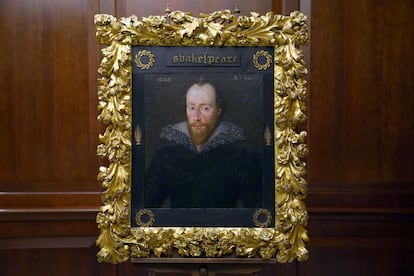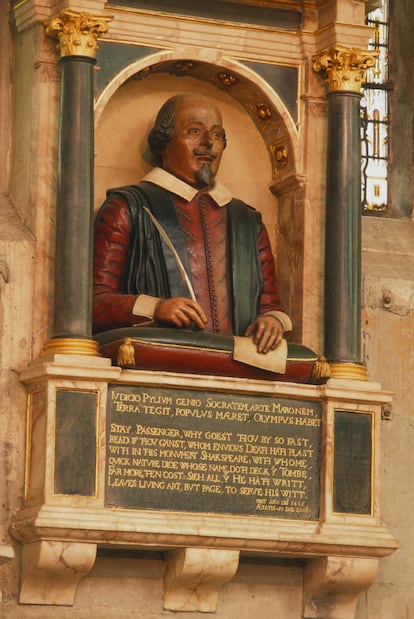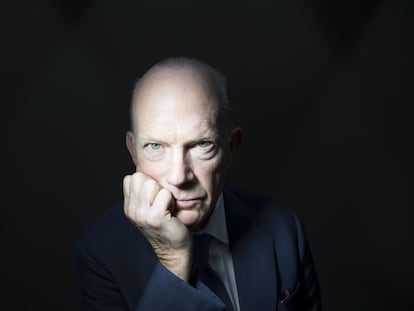Controversy over authenticity of new Shakespeare portrait revives mystery of his looks
The owner of a painting said to be a true likeness of the playwright wants to sell it for over $12 million, but experts disagree on whether it is the real thing

History is littered with characters without a portrait, or with such dubious reproductions of their image that these have not served to create an accurate memory. The head of Anne Boleyn, Henry VIII’s ill-fated second wife, has been depicted over and over again in novels, movies and TV series, despite the fact that an anonymous 16th-century oil painting is the only clue to that woman “with a long neck, a wide mouth and black, beautiful eyes,” as defined by the ambassador of Venice in the court of the Tudors.
The biggest mystery, however, is the one surrounding over what William Shakespeare looked like. There are only two representations of the Bard’s physical appearance: a bust at his funeral monument in his hometown of Stratford-upon-Avon, and a 1623 engraving on the title page of the First Folio, a compilation of his works. Over the years, there have been several claims regarding the legitimacy of Shakespeare portraits that have turned out to be wrong.
That is why the new portrait of the Bard on display these days at the Grosvenor House hotel in London has raised as much expectation as misgivings. Its owner wishes to remain anonymous, and is asking for over £10 million (around €11.6 million or $12.2 million). The sale is to be held by private treaty rather than an auction.
The painting shows a slim man with a receding hairline, light-colored eyes and a trimmed reddish beard, wearing a shirt and doublet. In the upper left corner of the oil painting there is a date, 1608, the year in which the playwright was at the zenith of his career. On the right, the initials AE and the number 44 can be seen. That would be Shakespeare’s age according to his birth certificate. He died eight years later, in 1616.
The portrait is by Robert Peake The Elder, court painter to James I. The artist received numerous commissions from the Office of Revels, a body in charge of theatrical and musical performances at the king’s court. His stylized initials showed up in the upper right-hand corner of the painting when the frame was removed. Peake’s studio was located in the London area of Clerkenwell, where many of Shakespeare’s works were rehearsed.
But there is no definitive proof of the authenticity of the painting. The name Shakespeare, which appears on the frame, does not prove anything because that frame was added a century or two later. There is only a series of clues and coincidences.

“It is a monogrammed and dated work by a portrait painter of serious status with connections to the artist who produced the image for the First Folio,” said gallery owner and art expert Duncan Phillips, who recently presented the work and has become its greatest promoter and defender.
The First Folio is the first compilation of Shakespeare’s 36 plays, published in 1623. The engraving of the author, which was very common in publications of the time, was the work of one Martin Droeshout. Experts believe that this portrait did not arise from direct observation, but was probably a copy of an existing painting. Robert Peake’s son, William, had an engraving shop and he knew Droeshout. That is the connection that Duncan Phillips highlights.
But the question lingers: how is it possible that until 1975, when it was auctioned at Christie’s, a painting showing the much-sought face of the most British yet universal author in history hung on a wall of the Swinton House mansion, owned by the Danby family, without anyone noticing its existence?
According to Phillips, “the picture has survived the past 400 years almost untouched by wear and tear thanks to its ownership by a family of Shakespeare enthusiasts who hung it in their library.”
In 2016 an analysis by the Courtauld Institute concluded that the pigmentation of the painting matched the alleged date of creation, and that its good state of conservation was due to the fact that it had remained untouched in the same place for a long time.
But Professor Michael Dobson, director of the Shakespeare Institute at the University of Birmingham and one of the leading experts on the work and life of the playwright, called it “wishful thinking.” In statements to the Daily Mail, he noted that “it is not labelled as a portrait of Shakespeare, who would surely have insisted on having his coat of arms in one corner of the canvas.” This expert also said that the painting bears no resemblance to either the Stratford funerary monument or the First Folio engraving.

The only similarity that has been found between the new work and those that the historical consensus considers authentic is a minor physical trait: a slightly drooping and swollen left eyelid, typical of a rare type of tear duct cancer that some doctors have attributed to Shakespeare, is there in the engraving and in the new painting, although much less noticeably in the latter.
Sign up for our weekly newsletter to get more English-language news coverage from EL PAÍS USA Edition
Tu suscripción se está usando en otro dispositivo
¿Quieres añadir otro usuario a tu suscripción?
Si continúas leyendo en este dispositivo, no se podrá leer en el otro.
FlechaTu suscripción se está usando en otro dispositivo y solo puedes acceder a EL PAÍS desde un dispositivo a la vez.
Si quieres compartir tu cuenta, cambia tu suscripción a la modalidad Premium, así podrás añadir otro usuario. Cada uno accederá con su propia cuenta de email, lo que os permitirá personalizar vuestra experiencia en EL PAÍS.
¿Tienes una suscripción de empresa? Accede aquí para contratar más cuentas.
En el caso de no saber quién está usando tu cuenta, te recomendamos cambiar tu contraseña aquí.
Si decides continuar compartiendo tu cuenta, este mensaje se mostrará en tu dispositivo y en el de la otra persona que está usando tu cuenta de forma indefinida, afectando a tu experiencia de lectura. Puedes consultar aquí los términos y condiciones de la suscripción digital.
More information
Archived In
Últimas noticias
Welcome to the post-religion era: The idea of Christianity as the absolute truth has become obsolete
‘I thought you would like it’: The risky sexual practice popularized by TV shows and TikTok
The digitalization of tourism: ‘They promise experiences and gave us the worst possible one’
Mexican peso defies uncertainty with forecasts of a new period of stability in 2026
Most viewed
- Sinaloa Cartel war is taking its toll on Los Chapitos
- Oona Chaplin: ‘I told James Cameron that I was living in a treehouse and starting a permaculture project with a friend’
- Reinhard Genzel, Nobel laureate in physics: ‘One-minute videos will never give you the truth’
- Why the price of coffee has skyrocketed: from Brazilian plantations to specialty coffee houses
- Silver prices are going crazy: This is what’s fueling the rally











































